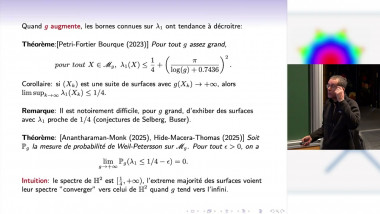
Problèmes ouverts et progrès récents en géométrie spectrale hyperbolique
By Frédéric Naud
Appears in collection : 2022 - T1 - WS3 - Mathematical models in ecology and evolution
We analyze a system of nonlocal reaction-diffusion equations describing the dynamics of adaptation of K phenotypically structured populations, under the effects of mutation, selection and migration in a K-patches environment, each patch being associated with a di˙erent phenotypic optimum in Rn. We give a characterization of the large-time behavior of the solution (persistence or extinction) based on the sign of a principal eigenvalue. We show that migration between environments decreases the chances of persistence. We mainly focus on the comparison between the case K = 2 (2 hosts) vs. the case K = 3 (3 hosts). We show that the ˝tness gain obtained when a third host is added to the system can be positive or negative, depending on the position of the third host in the phenotypic space. Thus, the presence of a third host can cause a springboard effect, a common pattern in zoonotic diseases, or on the contrary impede adaptation.
